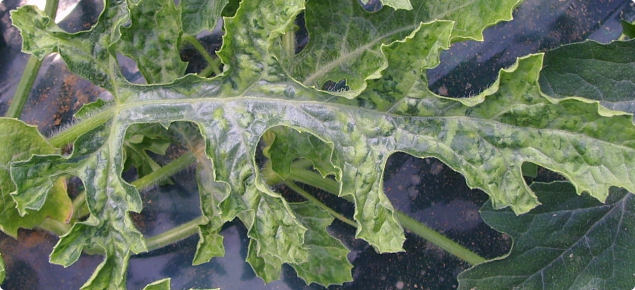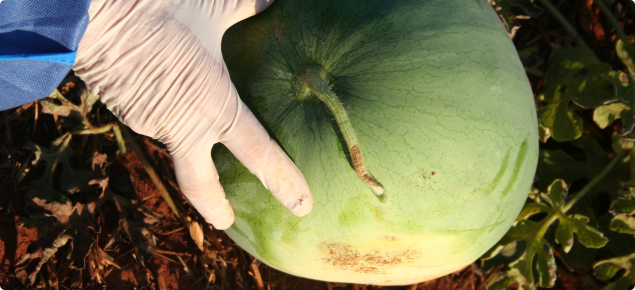- Report any suspect signs of CGMMV immediately to DAFWA’s Pest and Disease Information Service on 1800 084 881.
- Alternatively, download DAFWA’s MyPestGuide Reporter app to your smart phone, take a photo and follow the prompts on the device.
- A farm biosecurity plan template can be downloaded from this page.
- A farm biosecurity checklist can be downloaded from this page.
- Also visit the Farm Biosecurity website.
- Infromation sheets on sampling, disposal and destruction, and decontamination can be downloaded from this page.
- Refer to the vegetablesWA website for Vietnamese versions of CGMMV e-updates.
- ABC Country Hour interviews - 1 September and 19 September.
WA detections - as of 2 March 2017
CGMMV has been detected on a commercial cucurbit property in Kununurra, on seven commercial cucurbit properties in Geraldton, one in Carnarvon, one in Perth, and in native and naturalised weed species in Carnarvon.
There is no clear indication of how the virus entered WA – possibly through a number of different pathways.
Since November 2014 all cucurbit seed lines entering Australia have been subjected to increased levels of testing for CGMMV.
If you have older seed lines that entered Australia prior to November 2014, it is recommended you have them tested using the more stringent testing regime for CGMMV.
For recently purchased seed, cucurbit growers should seek a written statement from their seed suppliers stating that the seeds have been tested, using the ELISA method, and found to be free from the virus. This assurance should be obtained for both cultivars and rootstocks.
Biosecurity planning support for Geraldton
DAFWA met with Geraldton growers in November 2016 to help develop on-farm biosecurity plans. In 2017 DAFWA will arrange follow-up meetings to measure the up-take of planned biosecurity measures on each property.
Farm biosecurity
Information sheets
DAFWA has made available three information sheets on topics essential to maintaining good biosecurity:
- Sampling
- Disposal and destruction
- Decontamination
They provide detailed information on disposal options, how to collect samples for CGMMV testing, and how to clean and wash-down clothing, vehicles and equipment to prevent infection or spread.
The information sheets can be downloaded from this page.
Farm biosecurity checklist
Growers must observe strict on-farm biosecurity practices to minimise the risk of introducing and spreading CGMMV.
DAFWA strongly encourages the implementation of a Farm Biosecurity Plan. A CGMMV Farm Biosecurity Plan template can be downloaded from this page.
Below is a checklist of biosecurity measures that farms should aim to have in place. The checklist can also be downloaded from this page.
- Do you have biosecurity signs in place at property entrance? Does it include a phone number and instruction for visitors to contact the farmer before coming on farm?
- Can you manage access to your property through a single access that is able to be shut/locked?
- Do visitors, contractors and staff park in designated signed areas?
- Do you use certified CGMMV clean seed or own ‘clean and tested’ seeds?
- Are seedlings from a registered nursery and supplied in new trays?
- Has a seed/seedling register been completed?
- Are staff trained in biosecurity? Has the training been recorded?
- Are clothes and equipment cleaned daily or on re-entry?
- Are boots and secateurs used only on farm and cleaned between tunnel/planting blocks?
- Are footbaths available on your property?
- Do you restrict movement of vehicles on-farm?
- Do all visitors and contractors to the site sign a register and are they informed of your farm’s biosecurity measures and not to bring plant material on farm?
- Do all visitors use a footbath before entering the production area?
- Is there a concrete wash down area located near to the front of property with run-off collected so as not to contaminate the growing area?
- Do you clean any machinery or vehicles coming onto the growing area or leaving the farm with a high pressure cleaner and detergent?
- Is wash down water collected in confined area (sump, evaporation pond)?
- Do you maintain a complete register of machinery coming onto the farm?
- Do you use on-farm only vehicles, if possible, for transport around the growing area?
- Are all deliveries and produce pickups done at a designated area?
- Are field crates and bins washed and disinfected when moving from one production area to another?
- Are wooden pallets cleaned in a 1% Chlorine bath before going into the farm area and placed on a stand or hard surface area? Do you avoid used or recycled packaging?
- Is there a hardstand loading area that is cleaned once produce has been picked up?
- Do you know and can you identify the host weeds for CGMMV on your farm?
- Do you monitor host weeds and remove where possible, especially around wash down areas?
- Are fences and nets maintained to restrict access to production areas?
- Do you remove waste away from the growing area to a designated area?
- If possible do you dispose of waste by deep burial, burning or feeding to stock?
- Do you monitor your crops regularly for disease symptoms?
- Do you train workers to identify and report the symptoms of CGMMV?
Ongoing monitoring and sampling
Farm biosecurity measures should include ongoing monitoring of plants for CGMMV symptoms. DAFWA encourages all cucurbit growers, particularly in the south west of the state where there has been limited surveillance, to send in samples to determine presence or absence of CGMMV.
An information sheet on correct sampling procedures can be downloaded from this page.
Currently, CGMMV symptomatic leaf samples can be tested by DAFWA’s Diagnostic Laboratory Service (DDLS) free of charge.
Sampling kits can be obtained by sending a text message to DAFWA technical officer David Tooke on 0428 920 045.
National situation
CGMMV had been detected in Australia for the first time in the Northern Territory in 2014, and then in Queensland in 2015.
A national response to CGMMV was launched in late 2014 to manage the spread of CGMMV in Australia and mitigate economic impact. The National Management Group determined that it was not technically feasible to eradicate CGMMV.
The virus is now a pest of national significance and a National Management Plan has been endorsed by national industry groups with input from State and Commonwealth governments. The plan can be downloaded from the AUSVEG website.
WA is currently involved with two research projects to improve the understanding of CGMMV and develop management strategies for its control.
What plants are affected?
CGMMV affects cucurbit crops, including watermelon, cucumber, melons, zucchini, pumpkin, squash, bitter gourd, and bottle gourd.
What do I look for?
CGMMV can cause severe symptoms including fruit abortion, rotting, yellowing or dirty red discolouring of the internal fruit, or fruit malformation. It can appear as mosaic-like mottling on leaves, and can give a bleached appearance.
Symptoms on young seedlings may be indistinct or difficult to recognise as being caused by a virus, and may not be apparent until more mature leaves emerge.
Fruit may also be symptomless externally. In some cases, fruit showing no external symptoms may be internally discoloured or necrotic. This can be especially pronounced in watermelon.
There are at least five strains of CGMMV, whose symptoms can vary between hosts. Additionally, there are other mosaic diseases caused by potyviruses which are known to occur in northern Australia, which cause similar symptoms.
This makes it difficult to visually identify CGMMV. The virus must be conclusively established by laboratory testing, which can be undertaken by the AGWEST Plant Laboratories.
How does it spread?
CGMMV is mainly introduced into a crop through contaminated seed and soil. It can remain dormant within the seed coat, and viable for an extended period in plant debris and soil, or on vehicles, equipment and tools.
The virus can also be transferred by sap, with entry of the virus into plant cells being caused by regular pruning, staking and handling.
CGMMV can survive and be spread by:
- infection of roots from contaminated soil
- infected root stock and grafts
- root-to-root contact
- in water or nutrient solutions
- mechanical transfer — even the hands of persons who have been in contact with infected plants
- packagng materials such as harvest, storage or marketing bins
- infected seed
- chewing insects.
What damage can this disease cause?
The combined effects of CGMMV can result in substantial crop losses.
What do I do if I find it?
- Report any suspect signs of CGMMV immediately to DAFWA’s Pest and Disease Information Service on 1800 084 881.
- Alternatively, download DAFWA’s MyPestGuide Reporter app to your smart phone, take a photo and follow the prompts on the device.
- Growers can submit symptomatic leaf samples and seeds to DAFWA's diagnostic laboratory service (DDLS). Refer to the DDLS web pages for details or call (08) 9368 3351.
When sending samples, package the leaves between sheets of absorbent paper, such as newspaper, to prevent them getting crushed in transit and enter the locality where collected, date and collector’s contact details. It is important not to post specimens on a Thursday or Friday. This avoids deterioration while in transit over the weekend.


